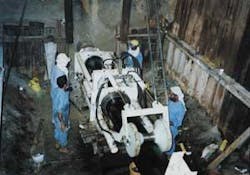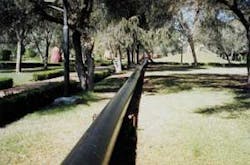Abu Dhabi renovates old gas pipe for water transport by swagelining
By Sanford Payton
Swagelining allows Abu Dhabi to replace urban pressure pipe with minimum disruption.
A swagelining project in the municipality of Abu Dhabi, United Arab Emirates is relining an old buried 18-inch steel pipe that was installed in the 1960s to transport gas 19 km along the spine of Abu Dhabi Island from an oil refinery to a power station. The project is scheduled for completion by 31 December 2002.
About 20 years ago, the municipal Sewerage Projects Division (SPD) began using the pipeline to form the backbone of a large irrigation network, which uses treated wastewater to nourish a major greenway running throughout the heart of the desert city. However, internal and external corrosion seriously weakened the pipeline after years of use, and threatened to completely disable it.
The SPD appointed the British engineering firm of Hyder Consulting to undertake a study to determine the best method to rehabilitate or replace the valuable pipeline. Hyder has been a consultant to SPD since 1974, providing services on many wastewater projects. Abu Dhabi had grown significantly during the past quarter century; busy streets and extensive greenways had been built over the old pipeline. The SPD wanted to minimise destructive and disruptive open trenches. They also wanted to avoid flow disruption in the pipeline as much as possible, and they wanted the project completed quickly at a reasonable cost. The new pipe had to have a stand-alone working pressure rating of 6 bars and a 50-year design life. Also, the hydraulic capacity of the original pipeline needed to be maintained.
SPD and Hyder studied many options during the engineering phase of the project including:
- Excavation and full replacement;
- Cured-in-place resin-impregnated felt liners;
- Spiral wound and folded UPVC or PE liners;
- Thin-walled tight-fit HDPE liners;
- Structural tight-fit HDPE liners.
Several of the systems examined had the ability to meet some design requirements, but only a structural, high-density polyethylene (HDPE) tight-fit liner met them all. The use of polyethylene (PE) as a stand-alone pipeline material has been widely proven in both laboratory tests and actual installations over the past 30 years. It is cost-competitive with other pipeline materials, lightweight, flexible, totally resistant to corrosion, and can be butt-fusion welded into virtually any leak-free length. It has a theoretical design life of 50 years, but will almost certainly last much longer. Using the Swagelining process, PE pipe can also be installed tightly inside a host pipe, leaving virtually no annular space.
The Swagelining process is licensed worldwide by Advantica Technologies, formerly a part of British Gas, and it was originally developed by the British gas and water industries as a trenchless rehabilitation technology for their own ageing distribution networks. The process is based on the molecular memory of PE pipe. This means that a PE pipe can be temporarily deformed within controlled limits, and when the deforming force is removed, the pipe will attempt to return to its original shape and dimensions. Years of research and development have proven that the Swagelining process has no detrimental effect on the polymer characteristics of PE pipe, nor its performance as a pipeline material.
The Swagelining process uses PE pipe that has an outside diameter slightly larger than the inside diameter of the pipe to be lined. During the installation process, PE pipe is pulled through a die to temporarily reduce its outside diameter. This reduction allows the PE pipe to be easily pulled through the host pipe. As a result, lengths up to 1,000 metres can be installed in a single "pull."
The PE pipe begins to return to its original diameter when the pulling force is disconnected. Just before the PE pipe relaxes completely, it presses tightly against the inside of the host pipe, eliminating virtually all annular space while only slightly reducing the inside diameter of the pipeline. The smoothness of the PE pipe can result in additional flow capacity, compared to corroded steel pipe.
Anticorrosion Protective Systems (APS), a Swagelining contractor operating in Abu Dhabi, worked closely with the local pipeline contractor Mace Contractors Company to develop an installation plan. Hyder reviewed the submission to assure the SPD that it would meet all of their specifications.
APS Chairman Robert Walters explained: "We've been using the Swagelining system in challenging situations for about ten years, but the set of challenges on the Abu Dhabi SPD project has been unique." His company was formed in the UAE in the late 1970s to provide corrosion engineering contracting services to the oil, gas, power, and water industry.
The first challenge was to select a PE pipe that could withstand the six-bar operating pressure without reliance on the host pipe. Because the temperature of the water entering the pipeline is about 35°C throughout the summer, APS chose an HDPE 100 pipe with a 23-mm wall thickness. The 456-mm pre-insertion outside diameter of the liner would pass through the reduction die before being pulled into the host pipe, which had an inside diameter of 446 mm. This was the first time a PE 100 pipe of this diameter and wall thickness had ever been installed using the Swagelining process.
APS selected 60 pit sites along the pipeline to accommodate the location of branches and valves, and to minimise disruptions to pedestrian and vehicular traffic. Most pits were about 250 metres apart, with the greatest distance being 495 metres. Each pit had an eight-by-four-metre footprint and was two to three metres in depth.
Another challenge was the requirement that no greenery area served by the pipeline could be left without water for more than 48 hours. Arrangements had to be made to supply water by bypass pipe if a section of the pipeline needed to be out of service for longer than 48 hours. If alternatives were not possible, the pipeline had to be temporarily reconnected before flow could be interrupted again.
An electronic pig was used to inspect some areas of the pipeline to determine their exact condition, configuration, and the locations of lateral lines or any other conditions, which might affect the installation. Then, as each section of the pipeline was isolated prior to installation, the heavy scale inside the pipeline was removed by using bi-directional scraper pigs, a brush pig, and finally a rubber "squeegee" pig.
Following cleaning, closed-circuit television (CCTV) was used to inspect the inside of the main. A proving pig, a short length of HDPE pipe with a diameter similar to the liner pipe after passing through the Swagelining die, was towed through. This step ensured that the liner could pass through the old pipeline without being harmed.
Once the host pipeline was proven clean, a cable from a winch in the receiving pit pulled the HDPE liner through the reducing die and the old steel pipeline at a steady rate of about two metres per minute. The pull continued until a few metres of the HDPE liner had cleared the host pipe in the receiving pit. Within 24 hours, the reduced HDPE pipe relaxed and reverted toward its original diameter until it pressed tightly against the inside wall of the host pipe. Before being returned to service, each line section was hydrostatically tested to nine bars. No leaks were found in the liner or its connections.
Chartered Civil Resident Engineer Ross Cailliau of Hyder Consulting commented on the project as it nears completion: "On a drawing, the project looks like a straight pipe with plenty of access points, but it was much more difficult than that. Mace and APS have had to constantly investigate and adapt procedures to overcome each new challenge as it appeared. The client will have the long-term use of a corrosion-resistant, structural pipe which was installed with minimal environmental disruption and economic cost."
Author's note
Sanford Payton is a freelance technical writer based in Nashville, Tennessee, USA.




